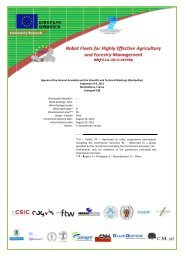1st Workshop BOOK - project RHEA
1st Workshop BOOK - project RHEA
1st Workshop BOOK - project RHEA
Create successful ePaper yourself
Turn your PDF publications into a flip-book with our unique Google optimized e-Paper software.
A Five-Step Approach for Planning a Robotic Site-Specific Weed Management<br />
Program for Winter Wheat<br />
A Five-Step Approach for Planning a Robotic Site-Specific<br />
Weed Management Program for Winter Wheat<br />
Cesar Fernández-Quintanilla*, Jose Dorado*, Carolina San Martín*,<br />
Jesus Conesa-Muñoz** and Angela Ribeiro**<br />
�<br />
*Institute for Agricultural Sciences (CSIC), C/ Serrano 115B, 28006 Madrid, Spain<br />
(e-mail: cesar@ica.csic.es)<br />
**Centre for Automation and Robotics (UPM-CSIC), Crtra. Campo Real Km 0,2<br />
28500 Arganda del Rey, Madrid, Spain<br />
(e-mail: angela.ribeiro@csic.es)<br />
Abstract: A Five-Step procedure is proposed to be used in weed control programs<br />
based on the use of a robot fleet. The five steps are: 1) field inspection, 2) longterm<br />
decisions, 3) current year decisions, 4) unit distribution & path planning, and<br />
5) online decisions. Monitoring weed populations at various times could be<br />
achieved using unmanned aerial vehicles (UAV) equipped with cameras and GPS. A<br />
long-term decision module could be used to optimize the choice of crop and<br />
herbicide rotations as well as the tillage system. A computerized system should<br />
quickly query databases containing information about the weeds present in each<br />
field and the herbicides available to control them, performing calculations to<br />
determine the cost effectiveness of each option. The system should generate a<br />
georeferenced prescription map indicating the sites were each herbicide should be<br />
sprayed. This map should provide the information required to decide the optimal<br />
distribution of the spraying units of the fleet and their corresponding navigation<br />
plans. Final spraying decisions should be based on both, prescription maps and<br />
online information coming from sensors located in the sprayer.<br />
1. Introduction<br />
Weed control can be approached either on a hit or miss basis or as a carefully<br />
planned and coordinated program. The second alternative is most likely to yield<br />
success. A well planned program consists of a number of appropriate operations<br />
coordinated in a sequence. Various types of weed management programs have<br />
been devised to fit different types of situations (Clarke, 2002; Newman, 2002;<br />
Sheley et al., 2010).<br />
3




